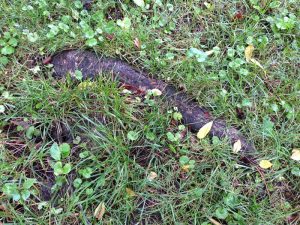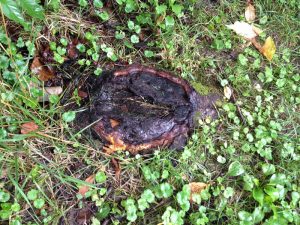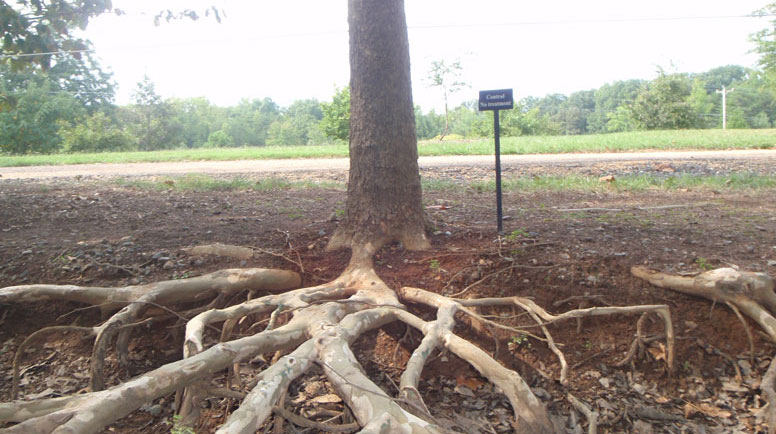The pollination game: How trees reproduce
When it comes to reproducing, being rooted to the spot can sometimes seem like a disadvantage for trees. Unlike animals they can’t go out in search of a mate; however trees have evolved a few ways around this problem.
The fundamental part of sexual reproduction for trees is that pollen must get from the anther of a flower on one tree to the stigma of a flower on a different tree.
Flowers and pollen
There are variations, but the typical flower is made up of male stamens with anthers at the tips holding the pollen. The female parts of the flower are the carpels each containing an ovary with a style protruding tipped with a stigma which receives the pollen.
Most flowers have both stamens and carpels (having both male and female flower parts is known as hermaphrodite) but some trees produce separate male and female flowers such as oaks. Other species, such as ash and holly, produce male and female flowers on separate trees.
The basics are the same for conifers with the aim of getting pollen from one cone to another. All cones are male or female, never hermaphrodite.
Wind power
Relying on wind pollination may seem a risky strategy, after all the pollen may not reach another tree let alone a stigma. But they produce lots of pollen (sorry hay fever sufferers) to increase the chance of pollination.
Wind pollinated trees such as birch and hazel have catkins. Dangling off the branch the catkins allow the pollen to be easily shaken free by the wind. Hazel catkins emerge before the leaves allowing the pollen to be taken by the wind without the leaves getting in the way.
Wing power
Letting insects do the wing work sounds like the better option, but this requires investment from the tree. To attract the insects the trees have to advertise themselves as a destination point, reward the insect and make sure the insect leaves with some pollen.
The bright white flowers of bird cherry send the message to the insect world that nectar is available. The flowers release a fragrance irresistible to bees, butterflies and beetles.
The flower has to be just right, with the nectar and the anthers positioned and the right amount of nectar available. Too much nectar and the insect won’t need to visit another flower so won’t deposit the pollen.
When the insect stops for a sip the anther has to be in just the right spot to deposit some pollen. The pollen will usually be spiky or rough to help it stick.
Fruit and seed development
Once at the stigma the pollen germinates, burrowing a tube down the full length of the style to fertilise the ovule. Finally seed is produced and soon the tree might display fruits ready for dispersal.
Tree seed dispersal
There are many adaptations to ensure seeds are dispersed. Some seeds from fruit or nut trees, such as blackthorn and hazel, are attractive to birds and mammals. They are be eaten which distribute the seeds further afield or are collected and stored where they germinate.
Other seeds are wind-borne, such as birch and field maple. Their wing-like seeds glide in the air until they land on patch of ground and begin to grow. Funded by players of the People’s Postcode Lottery, we’re working with Kew’s Millennium Seed Bank on the . With our dedicated volunteers we’re collecting valuable seeds to create a national ex situ collection of genetically diverse UK tree seeds.
This spring, watch pollinating insects or look out for pollen escaping into the wind from catkins on a breezy day
.https://www.gardeningknowhow.com/ornamental/trees/tgen/trees-with-invasive-roots.htm
Home › Ornamental Gardens › Trees › General Tree Care Invasive Tree Root List: Trees That Have Invasive Root Systems General Tree Care By: Jackie Carroll Printer Friendly Version Image by John Loo Did you know that the average tree has as much mass below ground as it has above ground? Most of the mass of a tree’s root system is in the top 18-24 inches of soil. The roots spread at least as far as the most distant tips of the branches, and invasive tree roots often spread much farther. Invasive tree roots can be very destructive. Let’s learn more about common trees that have invasive root systems and planting precautions for invasive trees. Problems with Invasive Tree Roots Trees that have invasive root systems invade pipes because they contain the three essential elements to sustain life: air, moisture and nutrients. Several factors can cause a pipe to develop a crack or small leak. The most common is the natural shifting and movement of soil as it shrinks during droughts and swells when rehydrated. Once a pipe develops a leak, the roots seek out the source and grow into the pipe. Roots that damage pavement are also seeking moisture. Water becomes trapped in areas beneath sidewalks, paved areas and foundations because it can’t evaporate. Trees with shallow root systems can create enough pressure to crack or raise the pavement. Common Trees with Invasive Roots This invasive tree root list includes some of the worst offenders: Hybrid Poplars (Populus sp.) – These trees are bred for fast growth. They are valuable as a quick source of pulpwood, energy and lumber, but they don’t make good landscape trees. They have shallow, invasive roots and seldom live more than 15 years in the landscape. Willows (Salix sp.) – The worst members of the willow family include the weeping, corkscrew and Austree willows. These moisture-loving trees have very aggressive roots that invade sewer and septic lines and irrigation ditches. They also have shallow roots that lift sidewalks, foundations and other paved surfaces and make lawn maintenance difficult. American Elm (Ulmus americana) – The moisture-loving roots of American elms often invade sewer lines and drain pipes. Silver Maple (Acer saccharinum) – Silver maples have shallow roots that become exposed above the surface of the soil. Keep them well away from foundations, driveways and sidewalks. You should also be aware that it is very difficult to grow any plants, including grass, under a silver maple. Planting Precautions for Invasive Trees Before you plant a tree, find out about the nature of its root system. You should never plant a tree closer than 10 feet from the foundation of a home, and trees with invasive roots may need a distance 25 to 50 feet of space. Slow-growing trees generally have less destructive roots than those that grow quickly. Keep trees with spreading, water-hungry roots 20 to 30 feet from water and sewer lines. Plant trees at least 10 feet from driveways, sidewalks and patios. If the tree is known to have spreading surface roots, allow at least 20 feet.
Read more at Gardening Know How: Invasive Tree Root List: Trees That Have Invasive Root Systems https://www.gardeningknowhow.com/ornamental/trees/tgen/trees-with-invasive-roots.htm
Read more at Gardening Know How: Invasive Tree Root List: Trees That Have Invasive Root Systems https://www.gardeningknowhow.com/ornamental/trees/tgen/trees-with-invasive-roots.htm
https://www.purdue.edu/hla/sites/yardandgarden/when-tree-roots-surface/
When Tree Roots Surface
Much to the dismay of homeowners, landscape trees sometimes grow roots on top of the surface of the lawn or possibly even buckle sidewalks and driveways. These surface roots can be quite a nuisance to lawn mowers and human feet.

Photo credit: Rosie Lerner
There are several reasons why the roots come to the surface. Some tree species are more prone to surface roots than others, most notably silver maple, poplar and willow. But almost any large, older tree can produce some surface roots.
Although trees do send some roots down deep for moisture and stability, most tree roots tend to grow much more shallowly than most people think – usually only 4-8 inches deep. Just as the trunk of the tree grows in girth with age, so do the roots. So over time, some of the shallow, older roots of the tree will naturally enlarge to the surface. Sometimes, roots become visible due to erosion of the surface soil. Compacted, poorly drained soil will also lead to more shallow root development.
Pruning off the visible roots is likely to cause serious damage to the tree over time and should only be used as a last resort to spare sidewalks and driveways where relocating the pavement is not feasible.

Photo credit: Rosie Lerner
The best prevention for surface roots is to select appropriate plants for the situation such as shorter tree species and planting at least 4 feet away from paved areas. But if you already have an older large tree with surfacing roots, you can adapt your landscaping maintenance to help avoid troubles.
A temporary solution to surface roots is to apply a shallow, 1 – 2 inch layer of good-quality soil mix and then replant the grass. However, it won’t be long before tree roots will reappear as they continue to grow in girth.
A more permanent solution would be to replant the affected surface area with a taller ground-cover type plant that will not need mowing, being careful to avoid injury to the major tree roots at planting. Or, better yet, replace the turf with organic mulch such as shredded or chipped hardwood bark.
Root barriers made of metal, plastic or fabric have been tried with some degree of success in slowing the development of surface roots. However, over time, most root barriers will fail, either through cracking of the material or roots growing under or over the barrier into decorative top mulch.
/Postshttps://www.loveyourlandscape.org/expert-advice/tree-care/soil-and-root-care/root-care-when-roots-
become-a-problem/
ROOT CARE: WHEN ROOTS BECOME A PROBLEM

If you see big roots exposed, curling or snaking on the soil’s surface around a tree, it can be a sign of trouble.
Tree roots normally grow just below ground, in the top 12 to 18 inches of soil. They spread much wider than most people realize, but they don’t stay on the surface unless they’re forced to. Roots can be exposed by:
- Rain, runoff or wind may erode the soil around roots. This is especially common on slopes.
- Lack of space. The tree may simply not have enough space for its roots, if it’s hemmed into a small area by sidewalks, streets, and buildings. When a growing root encounters an obstacle, such as a foundation or a curb, it may be deflected to the surface.
- Where people trample a tree’s roots zone, they may wear away the soil or pack it down so far it exposes the roots.
When roots are above the soil, they’re easily damaged. They can be sliced by lawnmowers or string trimmers, or worn and torn by foot traffic. Damaged roots can’t do their job of collecting water and nutrients to support the tree.
Don’t try to rebury the roots by piling on more soil. The soil may end up too deep or tightly packed, so the fine feeder roots can’t absorb oxygen.
Do spread mulch over the roots. This will:
- Cushion the roots
- Insulate them
- Discourage foot traffic
- Keep lawnmowers away (there’s no need to mow mulch)
Do use an organic material such as wood chips or shredded wood. Spread it in an even layer 3 to 4 inches deep over the surface of the soil.
Do make the area of mulch as large as it needs to be to completely cover the exposed roots, even if that means covering an area of lawn. It’s healthier for a tree to be surrounded by mulch than by grass.
Don’t pile mulch against the bark of a tree; that can lead to rot or disease. Always spread it evenly. Be on alert. The mulch will decay over time. When it grows thin, you can add more mulch right over the old, as long as it never gets more than 3 to 4 inches deep.
Exposed roots aren’t just a dangerous tripping hazard; they can spell danger for the trees they support. Take steps to protect mature trees by protecting their roots with good cover and insulation and then stay clear so you don’t create problems by your well intentioned attention.
Photo courtesy of Bartlett Tree Experts.





No comments:
Post a Comment